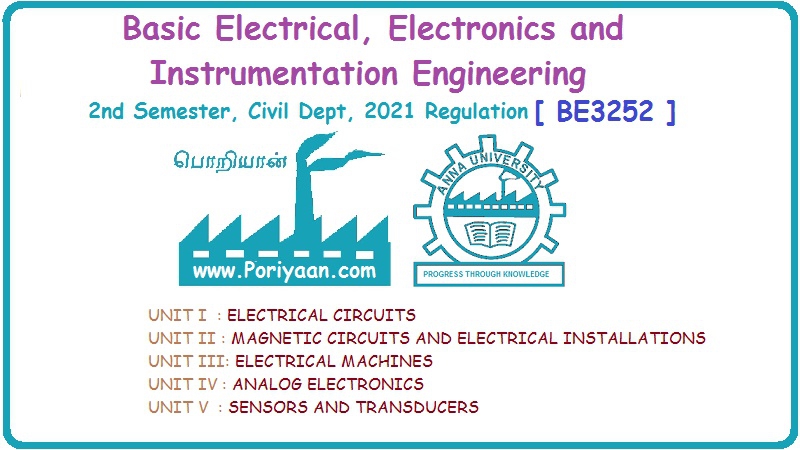Basic Electrical, Electronics And Instrumentation Engineering: UNIT II: Magnetic Circuits And Electrical Installations
Magnetic Circuits
The closed path followed by magnetic flux is called a magnetic circuit. In a magnetic circuit, the magnetic lines of force leave the north pole pass through the entire circuit and return to the starting point.
MAGNETIC
CIRCUITS AND ELECTRICAL INSTALLATIONS
MAGNETIC
CIRCUITS
The
closed path followed by magnetic flux is called a magnetic circuit. In a
magnetic circuit, the magnetic lines of force leave the north pole pass through
the entire circuit and return to the starting point. A magnetic circuit usually
consists of materials having high permeability such iron, soft steel etc. These
materials offer very small opposition to the flow of magnetic flux. Consider a
coil of N turns wound on an Iron core as shown in Fig. 2.1. When current is
passed through the coil, magnetic flux (6) is set up in the core. The flux
follows the closed path ABCDA and hence ABCDA is a magnetic circuit.

Basic Definition of Magnetic
Circuit
(a) Magnet
A
substance that attracts the iron pieces and pieces of some other metals is
called magnet. A magnet can be classified into a permanent and temporary
magnet.
(b) Permanent magnet
This
is made up of cobalt, steel or tungsten steel. It is used in moving coil
instruments, energy meters, loud speakers, microphones etc.U
(c) Temporary magnet 2TIUAI
It
is also called an electromagnet. The material used here is soft iron or silicon
steel. A soft iron piece with a coil acts as a magnet as long as currents flows
through the coil. It is used in electrical machines such as motor and
generator.
(d) Magnetic lines of force
The
imaginary magnetic lines which travels from north pole to south pole outside
the magnet, and south pole to north pole, inside the magnet are called magnetic
lines of force
(e) Magnetic Field
The
region around a permanent magnet or the space around a current carrying
conductor occupied by the lines of force is called the magnetic field of force
or magnetic field.
(f) Magnetic flux
The
amount of magnetic lines of force in a magnetic field known as magnetic flux.
These flux lines from a closed path and the path followed by the flux lines is
known as magnetic circuit. The unit of magnetic flux is weber (wb) and is
represented by the Letter (4).
(g) Magnetic flux density
The
flux density is the magnetic flux per unit area taken perpendicular to the
direction of the magnetic flux. It is usually denoted by the Letter of 'B' and
its unit is tesla (w/sqm). If a flux of (Φ) weber is passing through an area of
A square metre, then the flux density B is given by B= Φ/A

(h) Permeability
The
phenomena of magnetism and electromagnetism are dependent upon a certain
property of the medium is called its permeability. Every medium posses two
permeabilities.
•
Absolute permeability (μ0)
•
Relative permeability (μr)
(i) Absolute permeability (μ0)
The
magnetic conductivity of iron as compared to that of air is called
permeability. The absolute permeability (μ0) of a medium is given
below. Permeability of the medium

(ii)
Relative permeability μr
The
relative permeability μr of a medium is given by
μr
= B / B0
where,
B = flux density in the medium under consideration in wb/m2
B0
= Flux density in vacuum
μr
= 1 (air, free space, vaccum)
(k) Reluctance (S)
Reluctance
is the property of a material which opposes the establishment of magnetic flux
in it. It is defined as the ratio of magneto motive force to the flux.

(I) Permeance
It
is the reciprocal of reluctance and is a measure of the case with which flux
can pass through the material.

(m) Magneto Motive Force (MMF)
It is the driving force required to drive the
magnetic flux through a magnetic circuit. The product NI is called magneto
motive force.
MMF
= NI (AT)
where,
N→ No. of turns in the conductor
I→
Current in Ampere
(n) Magnetic Field Strength (H)
It
is given by the force experienced by unit north pole place at that point. It is
denoted by 'H'.

Basic Electrical, Electronics And Instrumentation Engineering: UNIT II: Magnetic Circuits And Electrical Installations : Tag: : - Magnetic Circuits
Related Topics
Related Subjects
Basic Electrical, Electronics and Instrumentation Engineering
BE3252 2021 Regulation | 2nd Semester Civil Dept 2021 Regulation
